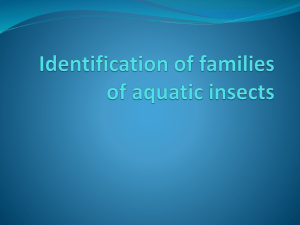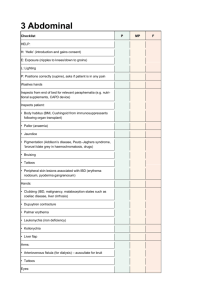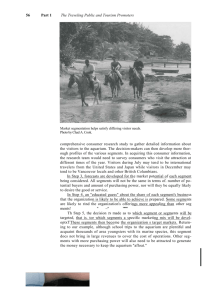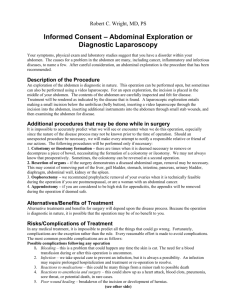Key to the Orders of Aquatic Insects and Collembola of Michigan
advertisement
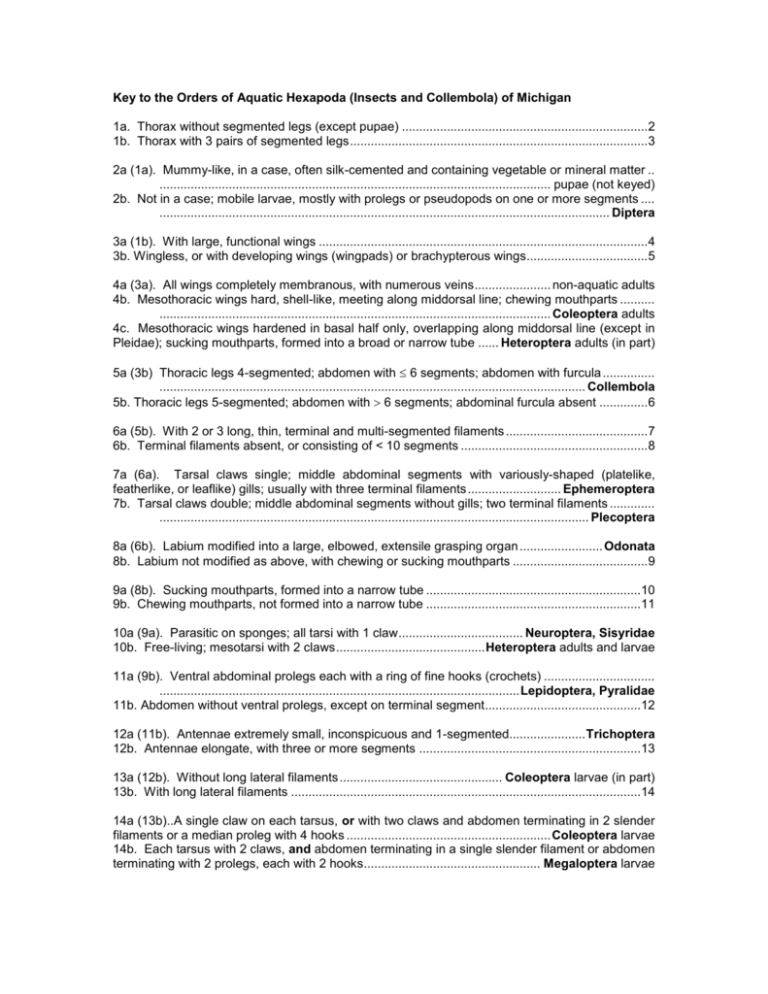
Key to the Orders of Aquatic Hexapoda (Insects and Collembola) of Michigan 1a. Thorax without segmented legs (except pupae) ....................................................................... 2 1b. Thorax with 3 pairs of segmented legs ...................................................................................... 3 2a (1a). Mummy-like, in a case, often silk-cemented and containing vegetable or mineral matter .. ................................................................................................................. pupae (not keyed) 2b. Not in a case; mobile larvae, mostly with prolegs or pseudopods on one or more segments .... .................................................................................................................................. Diptera 3a (1b). With large, functional wings ............................................................................................... 4 3b. Wingless, or with developing wings (wingpads) or brachypterous wings................................... 5 4a (3a). All wings completely membranous, with numerous veins ...................... non-aquatic adults 4b. Mesothoracic wings hard, shell-like, meeting along middorsal line; chewing mouthparts .......... ................................................................................................................. Coleoptera adults 4c. Mesothoracic wings hardened in basal half only, overlapping along middorsal line (except in Pleidae); sucking mouthparts, formed into a broad or narrow tube ...... Heteroptera adults (in part) 5a (3b) Thoracic legs 4-segmented; abdomen with 6 segments; abdomen with furcula ............... ........................................................................................................................... Collembola 5b. Thoracic legs 5-segmented; abdomen with 6 segments; abdominal furcula absent .............. 6 6a (5b). With 2 or 3 long, thin, terminal and multi-segmented filaments ......................................... 7 6b. Terminal filaments absent, or consisting of < 10 segments ...................................................... 8 7a (6a). Tarsal claws single; middle abdominal segments with variously-shaped (platelike, featherlike, or leaflike) gills; usually with three terminal filaments ........................... Ephemeroptera 7b. Tarsal claws double; middle abdominal segments without gills; two terminal filaments ............. ............................................................................................................................ Plecoptera 8a (6b). Labium modified into a large, elbowed, extensile grasping organ ........................ Odonata 8b. Labium not modified as above, with chewing or sucking mouthparts ....................................... 9 9a (8b). Sucking mouthparts, formed into a narrow tube ..............................................................10 9b. Chewing mouthparts, not formed into a narrow tube ..............................................................11 10a (9a). Parasitic on sponges; all tarsi with 1 claw .................................... Neuroptera, Sisyridae 10b. Free-living; mesotarsi with 2 claws ........................................... Heteroptera adults and larvae 11a (9b). Ventral abdominal prolegs each with a ring of fine hooks (crochets) ................................ ........................................................................................................ Lepidoptera, Pyralidae 11b. Abdomen without ventral prolegs, except on terminal segment .............................................12 12a (11b). Antennae extremely small, inconspicuous and 1-segmented...................... Trichoptera 12b. Antennae elongate, with three or more segments ................................................................13 13a (12b). Without long lateral filaments ............................................... Coleoptera larvae (in part) 13b. With long lateral filaments .....................................................................................................14 14a (13b)..A single claw on each tarsus, or with two claws and abdomen terminating in 2 slender filaments or a median proleg with 4 hooks ........................................................... Coleoptera larvae 14b. Each tarsus with 2 claws, and abdomen terminating in a single slender filament or abdomen terminating with 2 prolegs, each with 2 hooks ................................................... Megaloptera larvae Some Useful Order-Level Characteristics of the Aquatic Hexapoda Wing Folding Life Cycle Order Apterous Ametabolous Collembola Paleoptera Hemimetabolous Ephemeroptera Odonata Neoptera Holometabolous Plecoptera Heteroptera Megaloptera Neuroptera Trichoptera Lepidoptera Coleoptera Diptera Larval Jointed Abdomen No. Legs? Scleratized? Instars Y Y ? Y Y Y 20-30 10-20 Y Y Y Y Y usually Y N Y Y N N N N sometimes N 20-25 10-20 5 3 4-5 5-6 5 4 Y Key to the Michigan Families of Adult Collembola - Springtails 1a. Body somewhat globular; thorax and abdomen indistinctly segmented ................ Smithuridae 1b. Body elongate; thorax and abdomen distinctly segmented ....................................................... 2 2a (1b). Mouthparts directly downward; furcula present, and forks distinctly converge .................... .......................................................................................................Poduridae, Podura aquatica 2b. Mouthparts directed forward; furcula absent or forks do not distinctly converge ........................ ..................................................................................................................................Isotomidae Key to the Michigan Families of Larval Ephemeroptera - Mayflies 1a. Mandibles with large forward-projecting tusks; all gills on abdominal segments 2-7 with fringed margins, projecting dorsally or laterally ......................................................................... 2 1b. Mandibles without tusks; fringed gills absent or projecting ventrolaterally ................................ 4 2a (1a). Gills lateral, projecting from sides of abdomen; foretibiae slender, sub-cylindrical ............. ........................................................................................................................... Potamanthidae 2b. Gills dorsal, curving up over abdomen; foretibiae fossorial, expanded in width ....................... 3 3a (2b). Apex of metatibia rounded; mandibular tusks curved inward and downward apically, with at least one tubercle on inner margin near apex, or with many tubercles on upper surface ....... ................................................................................................................... Polymitarcyidae 3b. Apex of metatibia projected into an acute point ventrally; mandible tusks curved upward or outward apically .................................................................................................... Ephemeridae 4a (1b). Mesonotum modified into a carapace-like structure that covers the gills on abdominal segments 1-6 ...........................................................................................................Baetiscidae 4b. Mesonotum not modified into a carapace; gills exposed .......................................................... 5 5a (4b). Head and pronotum with pads of long, dark setae on each side; fringed gills projecting ventrolaterally; very rare, unlikely to be encountered except in large sandy rivers in western Michigan ................................................................................................................ Behningiidae 5b. Head and pronotum without pads of long, dark setae; without ventrolateral fringed gills .......... 6 6a (5b). Gills absent from abdominal segment 2, sometimes from 1 and 3 also; gills on segment 3 and 4 may be operculate, covering other gills ............................................... Ephemerellidae 6b. Gills present on abdominal segments 1-7 or 2-7....................................................................... 7 7a (6b). Gills on abdominal segment 2 operculate or semi-operculate, covering or partially covering gills on succeeding abdominal segments .................................................................... 8 7b. Gills on abdominal segment 2 similar to other gills ................................................................... 9 8a (7a). Operculate gills on abdominal segment 2 sub-triangular, well separated mesally; succeeding gills without fringed margins ........................................................... Leptohyphidae 8b. Operculate gills on abdominal segment 2 sub-quadrate and overlapping mesally; succeeding gills with fringed margins ..............................................................................................Caenidae 9a (7b). Head flattened dorsa-ventrally; eyes and antennae dorsal; gills a single lamella, often with a fibrilliform tuft .................................................................................................................10 9b. Head not flattened; antennae and eyes lateral; gills not as above ..........................................11 10a (9a). Gills with finger-like projection on lamellae; tarsal claws very long .......... Pseudironidae 10b. Gills without such a finger-like projection; tarsal claws normal ........................ Heptageniidae 11a (9b). Claws on protarsus much shorter than long, slender claws of meso- and metatarsi ....12 11b. Claws on all tarsi similar in length and structure ...................................................................13 12a (11a). Protarsal claw simple, with long, slender denticles; spinose pad present on procoxa .... .................................................................................................................... Ametropodidae 12b. Protarsal claw bifid; no spinose pad on procoxa ............................................ Metretopodidae 13a (11b). Prothoracic leg with dense row of setae along inner surface ......................................14 13b. Prothoracic leg without dense row of setae along inner surface ...........................................15 14a (13a). Gills single lamellae with fibrilliform tuft underneath of gill plate; gill tuft at base of procoxa................................................................................................................... Isonychiidae 14b. Gills on abdominal segments 2-7 small, lateral, lanceolate, with posterior fringe; gill on segment 1 large, fibrilliform, projecting between metacoxae ............................. Oligoneuriidae 15a (13b). Gills forked, or bilamellate and terminating in a filament or point ........ Leptophlebiidae 15b. Gills formed as single or double lamellae, sometimes with ventral fibrilliform tuft ................16 16a (15b). Abdominal segments 8 and 9 produced posterolaterally into distinct, flattened spines; if spines are weak, antennal length < 2x width of head ...........................................................17 16b. Abdominal segments 8 and 9 without such spines; if weak spines are present, antennal > 2x width of head ............................................................................................................Baetidae 17a (16a). Head, pronotum, and mesonotum with conspicuous lateral spines; a row of median spines on abdominal terga; very rare, only in large rivers with shifting sand substrates ............. ........................................................................................................ Acanthametropodidae 17b. Without such spines ..............................................................................................................18 18a (17b). Gills single, with sclerotized band on ventral margin and little or no tracheation; maxilla with crown of pectinate spines ..................................................................... Ameletidae 18b. Gills with well-developed tracheation; maxilla without pectinate spines .......... Siphlonuridae Key to the Michigan Families of Larval Odonata – Dragon- and Damselflies 1a. Body slender, head wider than thorax and abdomen ; abdomen ending with three caudal lamellae (gills are fragile, often falling off with rough or frequent handling of live or preserved specimens) .............................................................................................................. Zygoptera, 2 1b. Body stout, head usually narrower than thorax and abdomen ; no large caudal lamellae, rather body ending in 3 stiff, pointed valves, separated by pointed cerci .............. Anisoptera, 4 2a (1a). Antennal segment 1 elongate, as long or longer than remaining segments ; prementum with prominent cleft .......................................................................................... Calopterygidae 2b. Antennal segment 1 short, distinctly less than length of remaining segments .......................... 3 3a (2b). Labium long, in folded position reaching back to, or beyond, middle coxae, in basal half markedly narrowed ....................................................................................................... Lesitdae 3b. Labium shorter, in folded position never reaching the middle coxae, not markedly narrowed in basal half ......................................................................................................... Coenagrionidae 4a (1b). Mentum flat, Michigan species without premental and palpal setae ................................ 5 4b. Mentum spoon-shaped, usually with premental and always with palpal setae ........................ 7 5a (4a). Antennae 4-segmented, third segment often elongate ; fore and middle tarsi 2segmented ; ligula without a median cleft ............................................................... Gomphidae 5b. Antennae 6- and 7-segmented ; fore and middle tarsi 3-segmented ; ligula with a median cleft 6 6a.(5b). Antennae segments short, thick, and hairy ; prementum with sides sub-parallel in distal three-fifths, abruptly narrowed near base ; a pair of lateral-dorsal abdominal hair tuft present ; only in forested seeps in extreme southwestern Michigan ...................................... Petaluridae 6b. Antennal segments slender and bristle-like ; prementum widest in distal half, then much narrower in basal half or more ; abdomen without lateral-dorsal abdominal hair tufts ............... ............................................................................................................................ Aeshnidae 7a.(4b). Distal edge of lateral lobe with large, irregular teeth without associated setae, ligula with a median tooth-like cleft ................................................................................ Cordulegastridae 7b. Distal edge of lateral lobe entire, or with even-sized dentations, with associated setae ; ligula not as above .............................................................................................................................. 8 8a.(7b). Head with thick, erect frontal horn positioned between antennae ; metafemur very long, reaching at least to apex of abdominal segment 8 ; metasternum with broad, median tubercle . ........................................................................................................................Macromiidae 8b. Head without frontal horn positioned between antennae ; metafemur not reaching apex of abdominal segment 8 ; metasternum without median tubercle ................................................ 9 9a(8b). Distal edge of lateral lobe of labium with prominent crenations, usually at least as onefourth deep as wide ; cerci usually at least one-half as long as epiproct ; abdomen generally ends abruptly ...........................................................................................................................10 9b. Distal edge of lateral lobe of labium generally with crenations less than one-fourth as wide, or obsolete ; cerci usually less than one-half as long as epiproct ; abdomen distally more tapered ...................................................................................................... Libellulidae (in part) 10a (9a). Lateral spine of abdominal segment 8, when present, shorter than middorsal length of abdominal segment 9 .............................................................................................. Corduliidae 10b. Lateral spine of abdominal segment 8 as long as middorsal length of abdominal segment 9, or longer .........................................................................................Libellulidae, genus Pantala Key to the Michigan Families of Larval Plecoptera – Stoneflies 1a. Labial glossa and paraglossa subequal ................................................................................... 2 1b. Labial paraglossa produced much further than the glossa ...................................................... 6 2a (1a). Large tufted gills on the sides of abdominal segments 1 and 2 ............... Pteronarcyidae 2b. No such gills .............................................................................................................................. 3 3a (2b). Thorax robust, wider than abdomen; developing wing pads divergent ............................ 4 3b. Thorax and abdomen about equal in length; wing pads roughly parallel ................................. 5 4a (3a). Tarsomere 2 subequal or greater than 1 ............................................... Taeniopterygidae 4b. Tarsomere 2 much shorter than 1 .......................................................................... Nemouridae 5a (3b). Mesothoracic wing pads similar in shape, 2-3x farther apart than metathoracic pads ; abdominal segments 7-9 a complete sclerotized ring, not divided by a ventrolateral fold ......... ............................................................................................................................ Leuctridae 5b. Mesothoracic wing pads subequally separated or absent, or metathoracic wing pad truncated ; terga and sterna of abdominal segments 1-9 divided by a membranous fold ventrolaterally ............................................................................................................ Capniidae 6a (1b). Finely branched gills present on all thoracic sterna ..............................................Perlidae 6b. Finely branched gills, if present, only on first thoracic sterna ................................................... 7 7a (6b). Margins of metathoracic wing pads divergent; cerci roughly the length of abdomen; apical segment of labial palp basally about as wide as preceding segment ............ Perlodidae 7b. Margins of metathoracic wing pads nearly parallel ; cerci about 0.75x the length of abdomen ; apical segment of labial palp basally much thinner as preceding segment (rare in MI) ............. ..................................................................................................................... Chloroperlidae Key to the Michigan Families of Larval Trichoptera – Caddisflies 1a. Larval case of sand grains resembling a snail case ; anal claw with comb of teeth, not hookshaped ........................................................................................................... Helicopsychidae 1c. Larval case and anal claw not as above .................................................................................... 2 2a (1b). All three thoracic segments with dorsal sclerotized plates ................................................ 3 2b. Metanotum, and sometimes the mesonotum, entirely membranous or largely so but with several pairs of smaller sclerites ................................................................................................ 4 3a (2a). Abdomen with ventrolateral branched gills ; anal proleg projecting freely from abdomen, with brush-like setae and large anal claw ; posterior margin of meso- and metanotal plates lobate .............................................................................................................. Hydropsychidae 3b. Abdomen lacking ventrolateral gills ; anal proleg usually not projecting freely from abdomen, claw always small and without setal brush ; small (<6 mm), construct purse- or barrel-shaped portable cases, or silken domes fastened to rocks .............................................. Hydroptilidae 4a (2b). Antennae long and prominent, at least 6x as long as wide, and/or sclerotized plates on mesonotum lightly pigmented except for pair of dark curved lines on posterior half ................... ........................................................................................................................ Leptoceridae 4b. Antennae of normal length, < 3x as long as wide and usually no more than an inconspicuous stub ; mesonotum never with pair of dark curved lines as above .............................................. 5 5a (4b). Mesonotum usually lacking sclerotized plates , or with only small sclerites covering not more than half of notum ; pronotum never with anterolateral lobe ............................................ 6 5b. Mesonotum largely covered by sclerotized plates, variously subdivided and usually pigmented; pronotum sometimes with prominent anterolateral lobe ......................................11 6a (5a). Abdominal segment 9 with dorsal sclerotized plate ........................................................... 7 6b. Abdominal segment 9 without dorsal sclerotized plate ............................................................. 8 7a (6a). Larvae construct tubular portable case, usually of plant material ; prosternal horn present ................................................................................................................ Phryganeidae 7b. Larvae construct tortoise-like portable case of rock fragments ; without prosternal horn; basal half of anal proleg broadly joined to abdominal segment 9, anal claw with at least one dorsal accessory hook ............................................................................................ Glossosomatidae 7c. Larvae free-living without portable cases but construct fixed pupal enclosures; without prosternal horn; most of anal proleg free from abdominal segment 9, anal claw without dorsal accessory hook, although secondary lateral claw may be present ................. Rhyacophilidae 8a (6b). Labrum membranous and T-shaped , often withdrawn from view in preserved specimens; larvae construct fixed sack-like nets of silk .................................... Philopotamidae 8b. Labrum sclerotized, rounded and articulated in normal way .................................................... 9 9a (8b). Trochantin of prothoracic leg broad and hatchet-shaped, separated from episternum by dark suture line ; larvae construct fixed tubular retreats on rocks and logs ...... Psychomyiidae 9b. Trochantin of prothoracic leg with apex acute, fused completely with episternum without separating suture ; ..................................................................................................................10 10a (9b). Tarsi of all legs strongly flattened, tibiae shorter than tarsi ; larvae burrow into sandy deposits and construct tubes of sand grains ................................................... Dipseudopsidae 10b. Tarsi of all legs normal, not flattened, tibiae longer than tarsi ; larvae construct exposed funnel-shaped capture nets or flattened retreats ........................................ Polycentropodidae 11a (5b). Abdominal segment 1 lacking both dorsal and lateral humps , each metanotal sa1 lacking entirely or represented only by single setae without sclerite ............. Brachycentridae 11b. Abdominal segment 1 always with lateral hump on each side, though not always prominent, and usually with dorsal hump ; metanotal sa1 always present, usually with prominent sclerite with at least one setae ............................................................................................................12 12a (11b). Mesopleuron extended as an acute process ; cases of rock fragments .......... Goeridae 12b. Mesopleuron not extended as an acute process...................................................................13 13a (12b). Antennae situated close to anterior margin of eye ; no dorsal hump on abdominal segment 1 .................................................................................................... Lepidostomatidae 13b. Antennae not situated close to anterior margin of eye, ; dorsal hump on abdominal segment 1 almost always present...........................................................................................................14 14a (13b). Antennae situated approximately midway between anterior margin of head capsule and eye ; prosternal horn usually present although sometimes short ; chloride epithelia usually present on some abdominal segments .......................................................................15 14b. Antennae situated close to or at anterior margin of head capsule ; prosternal horn and chloride epithelia never present ...............................................................................................17 15a (14a). Mesonotal plates with anteromedian emargination ....................................... Uenoidae 15b. Mesonotal plates without such emargination .......................................................................16 16a (15b). Mandibles usually with uniform scraper blades , or if mandibles toothed , metanotal sa1 with 25 or more setae on membrane between sclerites ................................. Apataniidae 16b. Mandibles almost always toothed ; metanotal sa1 lacking setae on membrane between sclerites, or fewer than 25 setae if present ......................................................... Limnephilidae 17a (14b). Tarsal claw of hind leg modified to form short setose stub ; cases flat oval of sand with lateral flanges .......................................................................................................... Molannidae 17b. Tarsal claws of hind leg not different in structure from those of other legs ...........................18 18a (17b). Fore trochantin relatively large, apex hook-shaped ; dorsum of anal proleg with cluster of approximately 30 or more setae posteromesad of reduced lateral sclerite ............................ ................................................................................................................ Sericostomatidae 18b. Fore trochantin smaller, apex not hook-shaped ; dorsum of anal proleg with no more than 35 setae posteromesad of lateral sclerite, sometimes with short spines ............ Odontoceridae Key to the Michigan Families of Larval Megaloptera – Dobson- and Alderflies 1a. With 7 pairs of lateral segmented abdominal appendages; a long terminal anal filament; anal prolegs absent; larvae rarely exceed 25 mm in length .................................................. Sialidae 1b. With 8 pairs of lateral abdominal appendages that are not or imperfectly segmented; no terminal anal filament; anal prolegs present; mature larvae large, exceeding 30 mm ................ .......................................................................................................................... Corydalidae Key to the Michigan Families of Adult Heteroptera – Aquatic and Semi-aquatic Bugs Note: Lengths refer to adults, with have developed wings. 1a. Antennae shorter than head, concealed in groove beneath eye; aquatic ................................. 2 1b. Antennae as long, or longer, than head, usually plainly visible; semiaquatic ........................... 8 2a (1a). Rostrum broad, blunt, triangular, and indistinctly segmented; front tarsus broad, formed into a one-segmented scoop ....................................................................................... Corixidae 2b. Rostrum cylindrical or cone-shaped, distinctly 3- or 4-segmented; front tarsus not scoop-like .. 3 3a (2b). End of abdomen with a long, slender, rounded respiratory appendage ................Nepidae 3b. Apical respiratory appendages, if present, short and flat .......................................................... 4 4a (3b). Eyes protuberant; ocelli present; metathoracic leg without natatory setae; 7-9 mm, toadlike in appearance; riparian ............................................................................... Gelastocoridae 4b. Eyes not protuberant; ocelli absent; metathoracic leg with natatory setae; not toad-like in appearance ................................................................................................................................ 5 5a (4b). Very large, 18 mm in length; short, flat, retractile apical abdominal appendages present ............................................................................................................. Belastomatidae 5b. Smaller, < 16 mm in length; apical abdominal appendages absent .......................................... 6 6a (5b). Profemur almost as wide as long; body flattened; 10-12 mm long .................. Naucoridae 6b. Profemur elongate; body elongate or hemispherical; backswimmers ....................................... 7 7a (6b). Body shape hemispherical; small, 2.0-2.5 mm long ............................................... Pleidae 7b. Body elongate; larger, > 5 mm long ..................................................................... Notonectidae 8a (1b). Claws of at least protarsi inserted before apex .................................................................. 9 8b. Claws of all tasi at apex ...........................................................................................................10 9a (8a). Metafemur very long, greatly surpassing apex of abdomen ................................. Gerridae 9b. Metafemur shorter, not, or only slightly surpassing apex of abdomen .......................... Veliidae 10a (8b). Head as long as entire thorax; very slender; eyes set about halfway to base; 7.5 – 10.0 mm long ............................................................................................................. Hydrometridae 10b. Head short and stout, eyes near posterior margin ................................................................11 11a (10b). Winged, with veins in membrane of hemelytra; riparian ................................... Saldidae 11b. Wingless, or if winged, without veins in the membrane ........................................................12 12a (11b). Tarsi 3-segmented; head without deep longitudinal ventral groove to receive rostrum; rostrum completely visible from lateral view; legs with scattered, stiff, black bristles; body length 2.5-4.0 mm long ......................................................................................... Mesoveliidae 12b. Tarsi 2-segmented; head with deep longitudinal ventral groove to receive rostrum; rostrum only partially visible from lateral view; legs without bristles; smaller, body length < 2.0 mm....... ............................................................................................................................... Hebridae Key to the Michigan Families of Coleoptera – Beetles 1a. Wingless .......................................................................................................................Larvae, 2 1b. With well-developed, functional wings .........................................................................Adults, 12 2a (1a). Each tarsus with 2 claws .................................................................................................... 3 2b. Each tarsus with 1 claw ............................................................................................................. 5 3a (2a). Abdomen with 10 pairs of lateral filaments; 4 conspicuous hooks on last abdominal segment ...................................................................................................................... Gyrinidae 3b. Abdomen without lateral filaments or with only 6 pairs; without conspicuous hooks on last abdominal segment .................................................................................................................... 4 4a (3b). Urogomphi usually longer than last abdominal segment, but if shorter then legs elongate with natatory setae; posterior half of abdomen conspicuously narrowed; mandibles elongate, pointed for piercing.....................................................................................................Dytiscidae 4b. Urogomphi shorter than last abdominal segment; posterior half of abdomen little narrowed; legs stout, short and without natatory setae; mandibles short, adapted for chewing .. Noteridae 5a (2b). Legs distinctly 5-segmented; abdomen terminating in 1 or 2 long filaments ......Haliplidae 5b. Legs appearing 4-segmented; abdomen not terminating in long filaments .............................. 6 6a (5b). Mandibles large, readily visible from above ................................................. Hydrophilidae 6b. Mandibles not readily visible from above .................................................................................. 7 7a (6b). Antenna long, filiform, as long as head and thorax combined ............................. Scirtidae 7b. Antenna much shorter than head and thorax combined ........................................................... 8 8a (7b). Body oval, extremely flat; head completely concealed from dorsal view ...... Psephenidae 8b. Body elongate, round, or triangular in cross-section; head exposed ........................................ 9 9a (8b). Each thoracic and abdominal segment covered by a flat, plate-like sclerite dorsally; last abdominal segment with clump of large papillae ventrally ...................................... Lampyridae 9b. Thoracic and abdominal segments rounded dorsally; without clump of large papillae ventrally . .................................................................................................................................................10 10a (9b). All terga rounded and pale; grub-like larva with two spines on last abdominal segment .. ........................................................................................................................... Chrysomelidae 10b. Body elongate and sclerotized, with ventral movable operculum closing caudal chamber containing gills ..........................................................................................................................11 11a (10b). Last abdominal tergum apically notched; a group of 5 stemmata posterior to base of antenna .......................................................................................................................... Elmidae 11b. Last abdominal tergum broadly rounded; one ventral stemma below base of antenna in addition to 5 stemmata posterior to base ................................................................ Lutrochidae 12a (1b). Head formed into a snout or beak anteriorly; antenna geniculate ............ Curculionidae 12b. Head not formed into a beak or snout; antennae not geniculate ..........................................13 13a (12b). Two pairs of eyes, a dorsal and ventral pair divided by sides of head; meso- and metathoracic legs extremely flattened; tarsi folded fan-wise; shiny black beetles...... Gyrinidae 13b. One pair of eyes; meso- and metathoracic legs not extremely flattened; tarsi not folded fanwise ..........................................................................................................................................14 14a (13b). Metacoxae expanded into large plates that cover 2-3 abdominal sterna and bases of metafemora .................................................................................................................Haliplidae 14b. Metacoxae not expanded into large plates ............................................................................15 15a (14b). Prosternum with a postcoxal process extending posteriorly to mesocoxae; first visible abdominal sternite completely divided by metacoxal processes .............................................16 15b. Prosternum with postcoxal process absent or short; first visible abdominal sternite extending for its entire breadth behind coxal processes ..........................................................................17 16a (15a). Enlarged median metasternal keel present; protibia with large, curved spur at apex; scutellum concealed.................................................................................................... Noteridae 16b. Enlarged median metasternal keel absent; without large, curved spur at apex; scutellum concealed or exposed ................................................................................................Dytiscidae 17a (15b). Antenna short, club-shaped, with segment 4, 5, or 6 modified to form a cupule; maxillary palp usually longer than antenna ..............................................................................18 17b. Antenna filiform or pectinate, usually longer than maxillary palp ..........................................19 18a (17a). Antenna with 5 segments past cupule ....................................................... Hydraenidae 18b. Antenna with 3 segments past cupule .............................................................. Hydrophilidae 19a (17b). Antenna slender, filiform .................................................................................... Elmidae 19b. Antenna short with pectinate club ........................................................................... Dryopidae Key to the Michigan Families of Larval Diptera – True Flies 1a. Mandibles moving against one another in a horizontal or oblique plane; head capsule usually completely sclerotized and fully visible, but retracted and partially sclerotized in Tipulidae ....... ............................................................................................................. Suborder Nematocera, 2 1b. Mandibles or mouth hooks moving parallel to one another in a vertical plane ........................... ............................................................................................................ Suborder Brachycera, 13 2a (1a). Head capsule incompletely sclerotized, with longitudinal incisions of varying depths dorsolaterally, in extreme cases head reduced to several slender rods, and more or less retracted into thorax ..................................................................................................... Tipulidae 2b. Head capsule complete, without longitudinal incisions and incapable of retraction within thorax ......................................................................................................................................... 3 3a (2b). Body without distinct constriction between head and thorax; body appearing 7segmented, segments 1-6 each with a prominent ventral suctorial disk ......... Blephariceridae 3b. Body with distinct constriction between head and thorax; body not appearing as above, and without ventral suctorial disks .................................................................................................... 4 4a (3b). Abdomen terminating in a long, slender, retractile respiratory tube; abdominal and thoracic segments with multiple transverse ridges or rows of small setae or setiferous papillae; 1st 3 abdominal segments with a pair of ventral prolegs, sometimes very small, bearing a single, slender, curved claw .............................................................. Ptychopteridae 4b. Without having any of the above characteristics ....................................................................... 5 5a (4b). Thorax with segments fused, indistinctly differentiated, forming a single segment that is wider than the abdomen; thoracic and abdominal segments with prominent lateral fanlike tufts of long setae, and/or terminal segment with an anal setal fan .................................................. 6 5b. Thorax segments usually distinct, thorax and abdomen about equal in diameter, or abdomen wider (except Dixidae); setae on thoracic and abdominal segments not tufted, and anal fan of terminal segment absent ............................................................................................................ 7 6a (5a). Paired crochet-bearing prolegs ventrally on abdominal segments 1 and usually 2; abdomen with 2 flattened dorsolateral post-spiracular lobes having setose margins projecting above a conical, dorsally sclerotized segment bearing the terminal anus and anal papillae ...... ........................................................................................................................................ Dixidae 6b. Abdominal segments without prolegs; abdomen not as above ................................................. 7 7a (6b). Prothorax with 1 or a pair of prolegs ventrally.................................................................... 8 7b. Prothorax without prolegs ........................................................................................................11 8a (7a). Head capsule usually with a pair of conspicuous, folding, labral dorsolateral fans; posterior of abdomen swollen, with terminal ring or circlet of numerous radiating rows of minute hooks ..............................................................................................................Simuliidae 8b. Head capsule without labral fans; posterior of abdomen not swollen, posterior of abdomen not as above, although anal proleg(s) bearing crochets may be present .................................. 9 9a (8b). Spiracles on both ends of body, prothoracic spiracles on short stalks, and posterior spiracles opening into a transverse cleft between fingerlike processes on abdominal segment 8; prothoracic and anal prolegs unpaired; riparian ............................................. Thaumaleidae 9b. Without spiracles; prothoracic or anal prolegs usually paired, although a slight separation of apical spines may be present ..................................................................................................10 10a (9b). All body segments with prominent dorsal tubercles and/or setae ..................................... ......................................................................................................... Ceratopogonidae (in part) 10b. All body segments lacking prominent dorsal tubercles and setae ................... Chironomidae 11a (7b). Posterior 2 abdominal segments with long filamentous processes, pairs of such processes arising laterally on the penultimate segment, dorsolaterally on the terminal segment, and from near the apex of 2 elongate cylindrical prolegs that project posteroventrally from the terminal segment ....................................................................... Tanyderidae 11b. Posterior 2 abdominal segments without long filamentous processes; at most, only a single anal proleg present ..................................................................................................................12 12a (11b). All body segments secondarily divided into 2 or 3 subdivisions, with some or all of these subdivisions bearing dorsal sclerotized plates, remainder of integument with numerous dark spots, which, together with the dorsal plates, impart a gray-brown coloration; spiracles on both ends of body, posterior spiracles at apex of a relatively short, conical respiratory tube .............................................................................................................................. Psychodidae 12b. Body segments usually not secondarily divided; integument smooth, shiny, and creamy white, lacking all surface features except a few setae, and sometimes a retractile anal proleg bearing a few crochets; without respiratory tubes ........................... Ceratopogonidae (in part) 13a (1b). Sclerotized portions of head capsule exposed externally, although sometimes greatly reduced, in which case slender tentorial and metacephalic rods prominent internally ................ ........................................................................................................ Infraorder Orthorrhapha, 14 13b. External sclerotized portions of head capsule absent; head reduced to an internal cephalopharyngeal skeleton ........................................................... Infraorder Cyclorrhapha, 18 14a (13a). Head mostly visible, truncate in shape; body dorsoventrally flattened; margin of posterior spiracular chamber usually with long, soft setae .................................. Stratiomyidae 14b. Head vestigial or mostly retracted into thorax and elongate; body nearly circular in crosssection; spiracular chamber without long, soft setae ...............................................................15 15a (14b). Body cylindrical; first 7 abdominal segments girdled by fleshy swellings with 3-4 pairs of prolegs that may bear hooks; terminal segments of abdomen tapered or rounded, with spiracles present, but never with terminal lobes or appendages ............................... Tabanidae 15b. Body variable; abdomen with at most 1 pair of prolegs per segment, or with creeping welts; spiracles present or absent; terminal abdominal segment with 1-2 pairs of appendages or lobes .........................................................................................................................................16 16a (15b). End of abdomen with a pair of divergent, ciliated process, longer than prolegs; spiracles absent ....................................................................................................... Athericidae 16b. End of abdomen variable, but not ciliated as above, usually shorter than prolegs and reduced to fleshy lobes; abdominal segments with creeping welts or with prolegs lacking from first abdominal segment; spiracles absent or present .............................................................17 17a (16b). End of abdomen with spiracles surrounded by 4 smooth pointed lobes on last abdominal segment, with posterior spiracles situated at the base of the upper 2 lobes; metacephalic rods expanded posteriorly in dorsal view .................................. Dolichopodidae 17b. Usually without spiracles, with last abdominal segment with 1-4 rounded lobes bearing apical setae, and abdominal segments bearing paired prolegs with apical crochets; if with spiracles at end of abdomen, then posterior segment with only a single lobe below spiracles, and abdominal segments with ventral creeping welts; metacephalic rods slender posteriorly in dorsal view ................................................................................................................ Empididae 18a (13b). Pharyngeal skeleton with the “hypopharynx” produced as a median tooth; rare, predator on psychodid larvae in pitcher plants and waste-treatment plants ................ Phoridae 18b. Pharyngeal skeleton not so produced; rarely associated with pitcher plants .........................19 19a (18b). Posterior spiracular plates fused or very closely approximated, usually on apex of a retractile respiratory tube, often at least half as long as body ................................... Syrphidae 19b. Posterior spiracular plates always distinctly separated, whether mounted on a retractile respiratory tube or not ..............................................................................................................20 20a (19b). Caudal spiracular disc with palmate hairs surrounded by 8-10 lobes, some of which may be very short; body wrinkled .......................................................................... Sciomyzidae 20b. Caudal spiracular disk without palmate hairs; if surrounded by lobes, body not wrinkled ........ .................................................................................................................................................21 21a (20b). Posterior abdominal segment somewhat tapered, sometimes ending in a retractile respiratory tube; integument of posterior abdominal segments covered with setae or spinules, or with hair-like tubercles on some segments; posterior prolegs absent or shorter than respiratory tubes ...................................................................................................... Ephydridae 22b. Posterior abdominal segment rather truncate and/or integument with setae only on intersegmental areas; tubercles, if present, restricted to posterior abdominal segment; posterior prolegs as long as, or longer, than respiratory tube .................................... Muscidae

